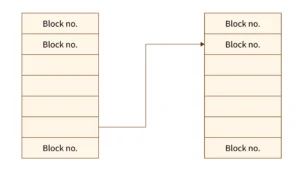Free Space Management
In any storage device, files and directories occupy blocks of disk space. However, some blocks remain unallocated—this is called free space. Managing this free space efficiently is essential for a file system to perform operations like file creation, expansion, and allocation without delays or wastage.
Free Space Management refers to the techniques used by an operating system to track which disk blocks are free and which are in use, so that new files or growing files can be properly stored without corrupting or overwriting existing data.
Why Is Free Space Management Important?
Whenever a file is deleted or modified, the space it occupied becomes available for reuse. Similarly, when a file is created or expanded, the system must find sufficient space to store it. Without a reliable mechanism to track and allocate free blocks, storage would quickly become disorganized, inefficient, or even unusable.
Efficient free space management helps to:
- Avoid unnecessary fragmentation.
- Speed up allocation and deallocation operations.
- Maximize utilization of disk space.
Common Free Space Management Techniques
1. Bitmaps (Bit Vectors):
In this approach, each bit in a bit vector represents a block on the disk. A value of 0 might indicate that the block is free, and 1 indicates it’s occupied. To find free blocks, the operating system scans the bit vector for zeroes.

This method is compact and easy to understand but may require memory overhead to keep the entire bitmap in RAM, especially for large disks.
2. Linked Lists:
Here, all free blocks are linked together as a list. The OS keeps a pointer to the first free block. Each free block then points to the next one, forming a chain.

This method is simple and eliminates the need for additional data structures, but it’s inefficient for searching large amounts of space at once since each free block must be examined in sequence.
3. Grouping:
Grouping improves on the linked list method by storing the addresses of several free blocks in a single free block. The first few entries in a block point to other free blocks, and one of them points to the next block of addresses.

This reduces the time spent traversing long chains and balances space and speed more efficiently.
4. Counting:
This method stores the address of a starting free block and a count of how many free blocks follow it sequentially. This is useful in file systems where free blocks tend to be contiguous.

It is memory-efficient and fast for large areas of free space but not suitable for heavily fragmented disks.
Challenges in Free Space Management
Even with efficient techniques, free space management must deal with practical challenges like:
- Fragmentation of free blocks over time.
- Synchronization in multi-user or multi-process environments.
- Keeping the free space structure updated reliably after every allocation or deallocation.
Incorrect tracking can lead to data corruption, where files overlap or inaccessible space remains wasted.
Summary
Free space management is a foundational task in file system design. By keeping an accurate and efficient record of which blocks are available, the operating system ensures smooth file operations, optimal space utilization, and high performance. Whether using bitmaps, linked lists, or grouping, the goal remains the same—keep track of what’s free so that the system can serve storage requests quickly and safely.